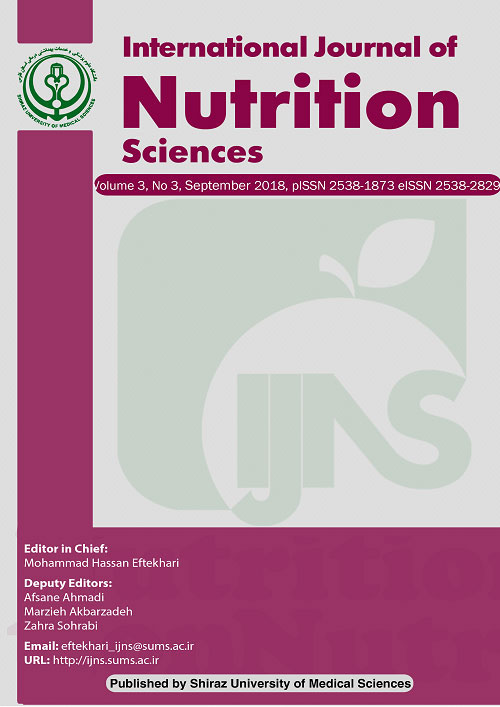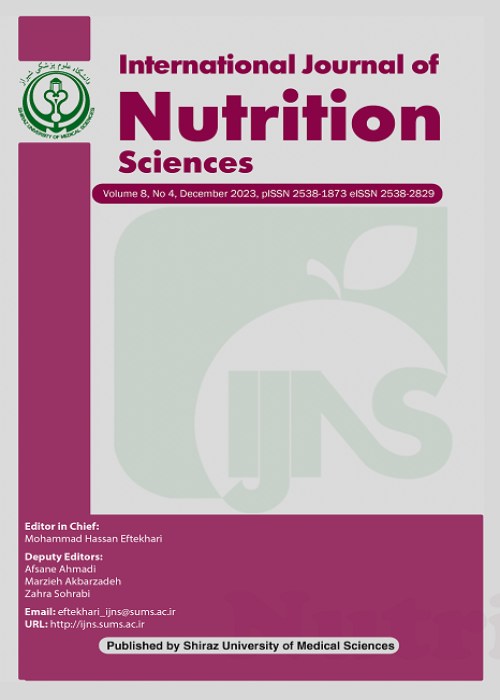فهرست مطالب

International Journal of Nutrition Sciences
Volume:6 Issue: 4, Dec 2021
- تاریخ انتشار: 1400/10/12
- تعداد عناوین: 8
-
-
Pages 164-171
In traditional Iranian medicine as well as the hadiths of the Imams about nutrition, there are important points that are needed to be considered. Dietary recommendations for the consumption of Black Corinth Raisin (Vitis vinifera L.) in Islamic religious books and the low probability of distortion in such hadiths on the other hand, can have high scientific support to ensure the physiological health of individuals. Emphasis has been undertaken on continuous eating of the fruits/nuts in these books to prevent the forgetfulness, enhance the memory and happiness, and improve physical health. This review has investigated the published studies in details on properties of red/black grape regarding the mentionedissues.
Keywords: Black corinth raisin, Vitis vinifera, Grape, Traditional medicine, Herbal -
Pages 172-179
Tahini is an oily paste made from mechanically hulled and ground sesame seeds. Tahini is considered a condiment in many regions of the world primarily in the Middle Eastern countries from the Levant region including Syria, Lebanon, Palestine, and Jordan. Sesame seeds contain about 25-35% protein, as well as at least 55% oil, predominantly unsaturated fat from oleic acid (35.9-47%), linoleic acid (35.6-47.6), palmitic acid (8.7- 13.8%), stearic acid (2.1-6.4%), and arachidic acid (0.1-0.7%). Tahini is widely known as one of the natural health promoting foods that has the potential to prevent various health problems such as hypertension, hypercholesterolemia, cancer and aging. Additionally, it may be useful in managing oxidative stress-associated diseases, such as atherosclerosis,diabetes mellitus, obesity, chronic renal failure, rheumatoid arthritis, and neurodegenerative diseases including Alzheimer’s disease. Moreover, sesame oil has multiple physiological functions, such as decreasing blood lipids, increasing antioxidative ability and γ-tocopherol bioavailability, and providing anti-inflammatory function and a potential estrogenic activity. Many health promoting effects are attributed to its lignans thatare consisted of sesamin and sesamolin. In sesame oils, the ranges of sesamin and sesamolin are 0.93-2.89 and 0.30-0.74 mg/g oil, respectively, with tocopherol contents of 304-647 μg/g oil. Lignans may increase antioxidant potential of diets and provide stability. Hence, this review will highlight and discuss the potential nutritional and health promotingeffects of Tahini.
Keywords: Tahini, Nutritive properties, Medicinal properties, Anti-inflammatory, Anti-oxidant -
Pages 180-188BackgroundObesity is a serious health problem that threatens public health. There are limited researches exploring the relationship between obesity and eating disorder risk and intuitive eating. The purpose of this study was to determine the rate of eating disorder risk and obesity, and identify the relationship between body mass index (BMI) and eating disorder risk and intuitive eating among young adults.MethodsThis cross-sectional study enrolled 1216 young adults. The data were obtained through a questionnaire consisted of three sections of socio-demographic information in the first part, Intuitive Eating Scale-2 (IES-2) in second part and Eating Attitudes Test-26 (EAT-26) in third part. Weight, height, and BMI of participants were also measured byresearchers.ResultsThe overall overweight/obesity rate of the participants was 16% (male=25.9%; female=10.9%). The rate of eating disorders risk was 24.3% in general (male=21.5%; female=25.4%). Overweight/obese had higher eating disorders risk than normal and underweight (26.7%, 23.8%, 21.6%, respectively). IES-2 score of underweight was significantly higher than overweight/obese (3.33±0.35, 3.20±0.37, respectively).ConclusionThis is the first study to examine the relationship between BMI and EAT-26 subscale showing that BMI was positively correlated with EAT-26 and negatively was correlated with IES-2 score. Therefore, BMI may be affected by eating behaviors and intuitive eating. Also, intuitive eating can be a new method of eating, and weight control and management.Keywords: Intuitive eating, Eating disorder, Body mass index, Young adults, Obesity
-
Pages 189-193BackgroundProblematic Internet Use (PIU) as an impulse-control disorder including “internet addiction” is commonly described as “a person’s incapability to overcome their excessive internet use, which in turn leads to distress and weakening of daily functional activities”. This study aimed to determine the dietary behavior of internet addicts among students.MethodsIn a cross-sectional study in Fatima Memorial College of Medicine and Dentistry,176 students aged 18-28 years were enrolled. A self-constructed questionnaire was used to evaluate demographic profile, level of internet addiction, dietary habits, physical activity, and snacking, and lifestyle patterns.ResultsTotally, 46.6% of students were mildly addicted to internet and 46% skipped the breakfast. Among internet addicted persons, snacking was found very common due to hunger, habit and lack of time for proper meal. The daily intake of fruits, vegetables, dairy, bread and cereal and meat was below WHO recommended amount and only 2.8% took appropriate amount. Only meat and fried food consumption were significantly and positively correlated with internet addiction.ConclusionThe study findings showed that addiction of students to the internet is increasing day by day and its negative effects on dietary patterns are evident. There is a need to plan interventions focusing on reducing screen time and promoting healthy eating.Keywords: Internet addiction, University students, Dietary behavior, Pakistan
-
Pages 194-200BackgroundDiabetes mellitus (DM) is a non-communicable disease that is generally associated with fasting blood glucose (FBG) level of >126 mg/dL and weight loss. Germinated black rice krisna (GBRK) extract contains phytochemicals with antioxidant and anti-diabetic properties. The purpose of this study was to assess the impact of GBRK extract on FBG level and body weight (BW) in rat model of DM.MethodsIn an in vivo pre- and post-test study 36 male Wistar rats with BW design, of 150-200 g were enrolled and divided into 6 groups, including control (C), negative control (NC), GBRK 535 mg/kg BW (P1), GBRK 1070 mg/kg. BW (P2), and GBRK 2140 mg/kg BW (P3). Diabetes was induced using streptozotocin (STZ) and nicotinamide (NA) and the intervention period was 14 days. Measurement of FBG level was by quantitative enzymatic colorimetric test of Glucose Oxidase Phenol 4-Aminoantipyrine (GOD-PAP) and body weight was determined by a digital scale.ResultsThe administration of GBRK extract in P1, P2, and P3 groups could significantly reduce the FBG (p <0.01). GBRK in P1, P2, and P3 groups could also significantly improve the body weight to normal state too (p <0.01).ConclusionGBRK extract at doses of 535, 1070, and 2140 mg/kg BW for 14 days was demonstrated to improve metabolic disorders in diabetes by reducing FBG level and improving the BW to the normal state.Keywords: Germinated black rice, diabetes mellitus, Blood glucose, Body weight, Antioxidant
-
Pages 201-207BackgroundSalt consumption has been linked to increased risk of development of type 2 diabetes mellitus and hypertension due to its glucose resistance and body weight promoting effects. This study investigated the effect of high dietary salt intake on renal function in diabetic male Wistar rats.MethodsAnimals were divided into 4 groups (n=7). Group 1 (control group) were fed with normal rat chow, group 2 (Diabetic) were received streptozotocin (STZ, 60 mg/kg), group 3 (high Salt) were given 8% salt diet, and group 4 had both STZ (60 mg/kg) and feeding with 8% salt diet. Fasting blood glucose was measured weekly and after 28 days priorto sacrifice, blood pressure measurements and 24 h urine samples were collected. After sacrifice, blood was collected and serum was separated for biochemical analysis. The kidneys were removed and preserved in 10% formalin for histological examination.ResultsSerum urea, creatinine and urine urea increased significantly (p <0.05) across group, when compared with control, while urine creatinine reduced (p <0.05) in all groups. There was a significant (p <0.05) increase in superoxide dismutase and catalase in high salt and salt/diabetes groups, when compared with diabetic group. Glutathione peroxidase significantly increased (p <0.05) across groups. Histologically, kidneys showed signsof inflammation in diabetic group, hemorrhagic lesions in high salt group and both hemorrhagic lesions and inflammation in salt/diabetes group.ConclusionHigh dietary salt consumption was shown to affect tubular and glomerular functions by altering kidney histoarchitecture and antioxidant defense system.Keywords: diabetes mellitus, High salt diet, Renal function, Streptozotocin, Rat
-
Pages 208-215Background
Dunaliella salina (D. salina) is a unicellular marine alga known for its carotenoid ingredient. Carotenoid has been used in food industry as a coloring additive and as an antioxidant. In addition, it has anticancer, antiaging, and immune-modulatory properties. Different methods have been used for extraction of carotenoids from algae. This study evaluated different extraction methods for carotenoid and comparedthe carotenoid yield and extraction time for procedures.
MethodsIn an experimental study, D. salina was isolated from Maharloo Lake in Shiraz, Iran. D. salina was centrifuged, dried, and suspended in methanol for further carotenoid extraction using different methods, namely ultrasound-assisted, supercritical fluid, microwave-assisted, electromantle, magnetic stirring, and maceration extraction methods.
ResultsSimultaneously, ultrasound-assisted, microwave-assisted, and electromantle extraction methods showed higher carotenoid yield and during a shorter time when compared with supercritical fluid, magnetic stirring, and maceration extraction methods. Since ultrasound-assisted extraction is a cold extraction method and ultrasound waves could release carotenoid and chlorophyll from broken cells to solvent quickly, the highest yields of carotenoid and chlorophyll were obtained during 10 min applying ultrasound-assisted extraction method. In contrast, the lowest yields of carotenoid and chlorophyll were undertaken by supercritical fluid extraction method.
ConclusionUltrasound-assisted extraction method was demonstrated to be a promising tool to recover higher value-added compounds from D.salina.
Keywords: Carotenoid, Dunaliella salina, Extraction, Microwave, Ultrasound


